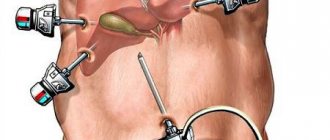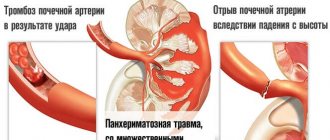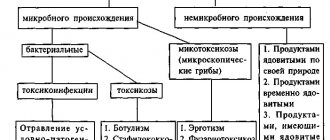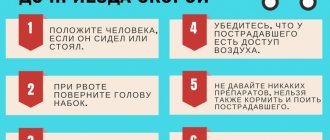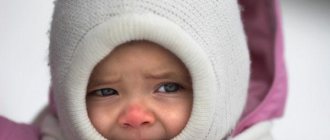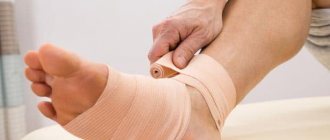Causes
Among the reasons, the main ones are:
- blockage of the gallbladder duct with a stone;
- entry and propagation of infection.
In the case when the drainage function is not impaired and there is no bile retention, the infection does not cause inflammation when it enters the gallbladder.
Causes of impaired outflow of bile from the bladder:
- stones;
- kinks of the elongated or tortuous cystic duct, as well as its narrowing.
Acalculous cholecystitis accounts for about 5−10% of the total number of cases of acute cholecystitis.
The main risk factors for the development of acute cholecystitis:
- severe illnesses (major operations, burns, injuries, sepsis);
- total parenteral nutrition and prolonged fasting, which provoke bile stagnation.
Treatment of acalculous cholecystitis
In the absence of complications (calculi), the disease is subject to conservative therapy. Treatment of chronic acalculous cholecystitis includes the use of medications to relieve inflammation, relieve unpleasant symptoms, and restore normal organ function. The basis of treatment is the following:
- drugs to improve the properties of bile;
- medications that normalize bladder tone;
- medications that relieve the inflammatory process.
The doctor selects antibiotics based on the results of bile tests. It is important to influence the cause, namely the bacterial flora that provoked the inflammation.
In 20% of cases, there is no improvement after conservative treatment. Then we are talking about planned surgical intervention.
Symptoms
At the initial stage, cramping sensations appear, which later, due to the increase in inflammation, become constant and more intense. This process can continue for several hours in a row along with vomiting. Characterized by a coated and dry tongue. Since the inflammation continues beyond the gallbladder, the mobility of the abdominal wall on the right during breathing is limited. In mild cases of the inflammatory process, body temperature rises to 37.5 to 38 °C, and in severe cases – up to 40 °C. The patient feels chills. The number of leukocytes in the blood increases.
The Ortner-Grekov symptom is observed, which is characterized by tingling in the right hypochondrium. When palpating the gallbladder, patients experience pain, which is more clearly manifested during deep inspiration (Murphy's symptom). Aggravating circumstances are expressed in blockage of the bile ducts. This leads to bloating, belching, nausea, jaundice, and a feeling of heaviness in the pit of the stomach. The described symptoms indicate increasing intoxication, dry mouth occurs, and gag reflexes become more frequent.
Publications in the media
Acute cholecystitis is an acute inflammation of the gallbladder. Frequency . Women over 40 years of age who are obese are more often affected. Acalculous cholecystitis most often develops in men.
Classification • Acute catarrhal cholecystitis. Inflammation is limited to the mucous and submucous membranes • Phlegmonous cholecystitis - purulent inflammation with infiltration of all layers of the gallbladder. Possible ulceration of the mucous membrane with subsequent exudation of inflammatory fluid into the paravesical space • Gangrenous cholecystitis - partial or total necrosis of the gallbladder wall. When the bladder wall is perforated, bile leaks into the abdominal cavity (gangrenous-perforative cholecystitis). Empyema of the gallbladder is purulent inflammation of the gallbladder.
Etiology • In 95% of cases, it develops due to obstruction of the cystic duct by a stone • Intestinal microflora is most often cultured from the wall of the gallbladder • Acalculous cholecystitis (5–10% of cases of acute cholecystitis in adults, up to 30% in children) can be associated with major surgical interventions, multiple injuries, extensive burns, recent childbirth, sepsis, salmonellosis, prolonged fasting, parenteral nutrition.
Pathogenesis • Stone obstruction leads to stagnation of bile and irritation of the gallbladder wall • Increased pressure in the gallbladder can lead to compression of the vessels of the gallbladder wall and its necrosis • Bacteria deconjugate bile salts with the formation of toxic bile acids that damage the mucous membrane of the gallbladder • In the pathogenesis of acalculous cholecystitis The significance of bile stagnation against the background of gallbladder paresis, an increase in its viscosity and lithogenicity have been established.
Pathomorphology • The gallbladder is distended, dull, contains turbid fluid or pus • Histologically, swelling of the wall and hemorrhages in the submucosa are revealed • As inflammation subsides, fibrosis develops.
Clinical manifestations
• Pain (hepatic colic) •• Localized in the epigastric or right hypochondrium •• Radiates to the back below the angle of the right shoulder blade, right shoulder, less often to the left half of the body •• Occurs at night or early in the morning, increases to a certain level and lasts 30–60 min without decreasing •• The occurrence of pain may be preceded by the consumption of fatty, hot, spicy foods, alcohol, emotional experiences •• Accompanied by increased sweating, a grimace of pain on the face and a forced posture - on the side with legs tucked to the stomach • Fever • Nausea, vomiting, sometimes with an admixture of bile • Shallow breathing, the stomach is weakly involved in the act of breathing • Murphy's symptom - involuntary holding of breath during inspiration with pressure on the right hypochondrium • Pain when inhaling during palpation of the right hypochondrium (Keur's symptom) • Pain when tapping along the edge of the right costal arch (Ortner's symptom) • Geno de Mussy-Georgievsky's symptom (phrenicus symptom) - pain when pressing with a finger between the legs of the right sternocleidomastoid muscle • Shchetkin-Blumberg's symptom becomes positive when the peritoneum is involved in the inflammatory process (peritonitis) • Jaundice (in 15% of patients) - caused by obstruction of the common bile duct with stones • On percussion of the abdomen - tympanitis (reflex intestinal paresis).
Laboratory tests • Blood test - leukocytosis, moderate shift of the leukocyte formula to the left • In 10-15% of patients (with concomitant choledocholithiasis, with acalculous cholecystitis), the concentrations of alkaline phosphatase and bilirubin are increased in the serum, bilirubin appears in the urine, with complete stone obstruction - urobilin disappears • Patients with fever may have positive blood cultures.
Instrumental studies • General radiography is performed for abdominal pain of unknown etiology • Ultrasound of the gallbladder reveals stones, thickening of the gallbladder wall, accumulation of fluid around it, with acalculous cholecystitis - gas in the bladder wall and detachment of the mucous membrane • Radioisotope scanning visualizes the common bile duct and intestines without filling the gallbladder indicates obstruction of the cystic duct (with acalculous cholecystitis, the method gives a large number of false positive results).
Differential diagnosis • Perforated or penetrating ulcer of the stomach and/or duodenum • MI • Pancreatitis • Hiatal hernia • Right lower lobe pneumonia • Acute appendicitis • Hepatitis • Infectious diseases.
TREATMENT
Diet . At the beginning of an attack of acute cholecystitis - a water-tea break • After 5-10 days, diet No. 5a is prescribed • If all acute phenomena disappear after 3-4 weeks - switch to diet No. 5.
Conservative treatment • Bed rest • Antispasmodics • Painkillers • Intravenous fluids • Antibacterial therapy •• If the patient is in a stable condition with pain and mild fever - ampicillin (4-6 g/day) •• For severe septicemia - a combination of gentamicin (3-5 mg /kg/day) with clinadmicin (1.8–2.7 g/day) or metronidazole with third generation cephalosporins, or imipenem + cilastatin.
Surgical treatment • The method of choice is early (within the first 72 hours) laparoscopic cholecystectomy, because with such an operation, mortality and the incidence of complications are lower than with a planned operation performed after 6-8 weeks of conservative treatment • Patients with acute cholecystitis, complicated peritonitis, gangrenous cholecystitis, perforation of the gallbladder wall are subject to • Percutaneous cholecystostomy in combination with antibacterial therapy - method of choice in the treatment of seriously ill patients, elderly patients with complications of acute cholecystitis • Emergency cholecystectomy is indicated for patients with acalculous cholecystitis; in case of critical condition of the patient, percutaneous cholecytostomy is performed under ultrasound control.
Complications • Empyema - acute purulent inflammation of the gallbladder • Perforation (15% of cases) •• Into the free abdominal cavity, the course is acute, mortality 30% •• Local - leads to the development of a peri-vesical abscess, the course is subacute •• Into the adjacent organ (duodenum, jejunum , colon or stomach), chronic course with the formation of a vesico-intestinal fistula • Sepsis • Pancreatitis.
Course and prognosis of the disease • In 85% of cases - spontaneous recovery, in 1/3 of patients a new attack develops within 3 months • Rapid progression of cholecystitis to gangrene or empyema of the gallbladder, formation of fistulas, intrahepatic abscesses, development of peritonitis is possible • Mortality in complicated cholecystitis reaches 50–60% • Mortality with acalculous cholecystitis is 2 times higher than with calculous cholecystitis, gangrene and perforation develop more often.
ICD-10 • K81 Cholecystitis
Diagnostics
Manual methods. To correctly diagnose acute cholecystitis, during the survey it is necessary to identify violations in the diet or the presence of stressful conditions, determine the symptoms of biliary colic, and palpate the abdominal wall.
Ultrasound. If there is a suspicion of acute inflammation of the gallbladder, it is necessary to perform an ultrasound of the abdominal organs. With its help, it is possible to record the enlargement of the organ, the absence or presence of stones in it.
CT (computed tomography). Computed tomography can provide a more detailed picture of the condition of the abdominal organs. To examine the bile ducts in detail, the ERCP (endoscopic retrograde cholangiopancreatography) technique is used.
Blood analysis. Allows you to identify signs of acute disease: leukocytosis, high ESR, bilirubinemia and dysproteinemia, increased enzyme activity (aminotransferases, amylase).
Treatment
Treatment of acute cholecystitis and relief of its symptoms cannot be carried out at home. At the first suspicion of this disease, you should immediately consult a doctor.
It often affects the muscle tissue of the walls of the gallbladder. They are destroyed, which leads to gangrenous cholecystitis and peritonitis. The latter often ends in death.
Treatment is usually surgery, which involves removing the entire gallbladder.
To make an appointment at the ABC-Medicine clinic for the treatment of acute cholecystitis, call +7 (495) 223-38-83.
Features of nutrition for cholecystitis
Nutrition plays an important role in the treatment of cholecystitis. In the acute phase of the disease, against the background of hunger, it is necessary to ensure the correct drinking regime: liquid is given in small portions with a total volume of about one and a half liters per day. After normalization of the general condition, steamed dietary cutlets, soups, cereals, and jelly are introduced into the diet.
Since bile stagnation is the main element in the pathogenesis of cholecystitis, it is necessary to ensure a stable rhythm of bile production and activate the excretory function of the bile ducts. For this, frequent split meals are recommended (5–6 times a day). In this case, the last main meal should be taken no later than 3 hours before bedtime.
The quality composition of food should also be adjusted: increase the proportion of animal protein in the diet, avoiding fatty, fried or smoked foods. Main dishes are steamed; it is also permissible to consume plant foods that are rich in vitamins and do not contain coarse fiber. The consumption of canned, salty, fatty foods, alcohol, as well as dairy products that cause increased gas formation is strictly prohibited.
